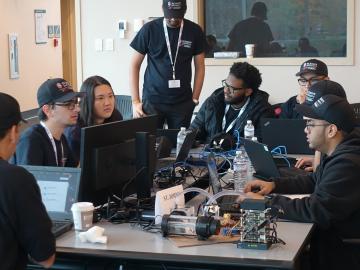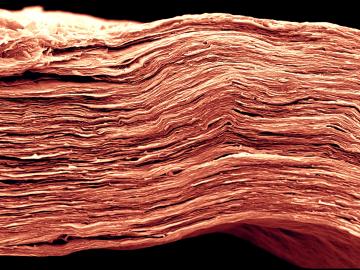
Filter News
Area of Research
- (-) Materials (56)
- (-) National Security (28)
- Advanced Manufacturing (2)
- Biological Systems (1)
- Biology and Environment (96)
- Computational Biology (2)
- Computational Engineering (1)
- Computer Science (4)
- Electricity and Smart Grid (3)
- Energy Science (119)
- Energy Sciences (1)
- Functional Materials for Energy (2)
- Fusion and Fission (8)
- Isotope Development and Production (1)
- Isotopes (29)
- Materials for Computing (8)
- Neutron Science (28)
- Nuclear Science and Technology (9)
- Quantum information Science (2)
- Sensors and Controls (1)
- Supercomputing (44)
News Topics
- (-) Biology (8)
- (-) Biomedical (8)
- (-) Cybersecurity (21)
- (-) Energy Storage (35)
- (-) Grid (11)
- (-) Isotopes (13)
- (-) Space Exploration (2)
- 3-D Printing/Advanced Manufacturing (25)
- Advanced Reactors (5)
- Artificial Intelligence (21)
- Big Data (7)
- Bioenergy (14)
- Biotechnology (1)
- Buildings (6)
- Chemical Sciences (32)
- Clean Water (3)
- Composites (9)
- Computer Science (33)
- Coronavirus (6)
- Critical Materials (13)
- Environment (20)
- Exascale Computing (2)
- Frontier (3)
- Fusion (8)
- High-Performance Computing (8)
- Irradiation (1)
- ITER (1)
- Machine Learning (16)
- Materials (74)
- Materials Science (78)
- Mathematics (1)
- Microscopy (27)
- Molten Salt (3)
- Nanotechnology (39)
- National Security (35)
- Neutron Science (35)
- Nuclear Energy (21)
- Partnerships (15)
- Physics (28)
- Polymers (17)
- Quantum Computing (3)
- Quantum Science (12)
- Security (11)
- Simulation (2)
- Summit (4)
- Transportation (16)
Media Contacts

In the race to identify solutions to the COVID-19 pandemic, researchers at the Department of Energy’s Oak Ridge National Laboratory are joining the fight by applying expertise in computational science, advanced manufacturing, data science and neutron science.

Energy storage startup SPARKZ Inc. has exclusively licensed five battery technologies from the Department of Energy’s Oak Ridge National Laboratory designed to eliminate cobalt metal in lithium-ion batteries. The advancement is aimed at accelerating the production of electric vehicles and energy storage solutions for the power grid.

The formation of lithium dendrites is still a mystery, but materials engineers study the conditions that enable dendrites and how to stop them.

To better determine the potential energy cost savings among connected homes, researchers at Oak Ridge National Laboratory developed a computer simulation to more accurately compare energy use on similar weather days.

Oak Ridge National Laboratory will give college students the chance to practice cybersecurity skills in a real-world setting as a host of the Department of Energy’s fifth collegiate CyberForce Competition on Nov. 16. The event brings together student teams from across the country to compete at 10 of DOE’s national laboratories.

Researchers at the Department of Energy’s Oak Ridge National Laboratory have received five 2019 R&D 100 Awards, increasing the lab’s total to 221 since the award’s inception in 1963.

A team of researchers at Oak Ridge National Laboratory have demonstrated that designed synthetic polymers can serve as a high-performance binding material for next-generation lithium-ion batteries.

Ionic conduction involves the movement of ions from one location to another inside a material. The ions travel through point defects, which are irregularities in the otherwise consistent arrangement of atoms known as the crystal lattice. This sometimes sluggish process can limit the performance and efficiency of fuel cells, batteries, and other energy storage technologies.


Gleaning valuable data from social platforms such as Twitter—particularly to map out critical location information during emergencies— has become more effective and efficient thanks to Oak Ridge National Laboratory.


